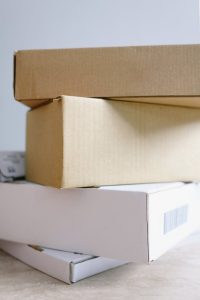
If you run an online business, you know how important solid product packaging is to deliver them safely to your customers.
But have you ever thought about the environmental impact of your packaging choices?
According to a study by the Ellen MacArthur Foundation, packaging accounts for 36% of all plastic produced, and only 14% of it is recycled. The rest ends up in landfills, incinerators, or oceans, where it can harm wildlife and ecosystems.
Fortunately, there are many ways to make your e-commerce packaging more sustainable and eco-friendlier, without compromising on quality, functionality, or aesthetics.
1. Use recyclable packaging

One effective way to make your packaging more sustainable is to use materials that can be easily recycled by your customers after use.
Reduce the amount of waste that goes to landfills or incinerators and contribute to the circular economy.
Some examples of recyclable packaging materials are:
Paper and cardboard
These are widely accepted by most recycling programs and can be turned into new paper products. Avoid using paper products that are coated with plastic or wax, as these can contaminate the recycling stream.
Corrugated boxes for example are a sustainable packaging material that consists of three layers of paper. The inner and outer layers are made of thick paperboard, known as the liners, while the middle layer is made of a thin, wavy sheet of paper called the fluting. The fluting creates air pockets between the liners, which provide cushioning and strength to the box. These boxes are widely used for shipping and storing various products, such as food, electronics, furniture, and clothing. They are durable, lightweight, recyclable, and customizable.
Plastic
Certain types of plastic can be recycled into new plastic products if clean and sorted by type. However, not all types of plastic are accepted by all recycling programs, so check with your local authorities before choosing plastic packaging. Avoid using plastic products that are mixed with other materials, such as metal or paper, as these can be difficult to separate and recycle.
2. Use compostable packaging

Making your packaging more sustainable by using materials that can be composted by your customers after use can help reduce the amount of waste that goes to landfills or incinerators and create valuable organic matter that can enrich the soil.
Some examples of compostable packaging materials are:
Plant-based plastics
These are made from renewable sources such as corn, sugarcane, or potatoes, and can be composted under certain conditions.
Natural fibres
These are made from materials such as cotton, hemp, jute, or bamboo, and can be composted if they are untreated and free of synthetic materials.
When using compostable materials, check that they are certified by third-party organizations such as the BPI or the TUV Austria OK Compost label and make sure to inform your customers on how to compost them correctly by providing clear instructions or symbols on your packaging.
3. Use reusable or refillable packaging

Another way to make your packaging more sustainable is to use materials that can be reused or refilled by your customers after use to extend the lifespan of your packaging and reduce the need for new materials.
Some examples of reusable or refillable packaging materials are:
Metal
This can be reused or refilled for products such as beverages, personal care items, spices,
or oils. You can offer incentives for customers to return or exchange empty metal containers for new ones, or partner with local refill stations where customers can refill their own containers.
Fabric
This can be reused for products such as clothing, accessories, linens, or bags. You can offer incentives for customers to return or exchange old or damaged fabric products for new ones, or partner with local repair or donation services where customers can extend the life of their fabric products.
When using reusable or refillable materials, make sure to design your packaging to be durable, easy to clean, and attractive.
4. Reduce the size of your packaging

Save materials, space, weight, and emissions, while also improving the customer experience by reducing the size of your packaging. Use right-sized boxes or mailers that fit your products snugly and avoid excess empty space.
Choose flexible packaging such as bags, pouches, or wraps that conform to the shape of your products and take up less space than rigid packaging.
And opt for multipurpose packaging that can serve more than one function, such as boxes that can double as gift boxes or display cases, or bags that can double as tote bags or storage bags.
Conclusion
There are many ways to make your e-commerce packaging more sustainable and eco-friendlier. By choosing recycled, recyclable, reusable, refillable, compostable, or reduced packaging materials, you can not only reduce your environmental impact but also enhance your brand image, customer loyalty, and profitability.
![]()
Author Profile
- Online Media & PR Strategist
- Blogger and Educator by Passion | Senior Online Media & PR Strategist at ClickDo Ltd. | Fascinated to Write Lifestyle Blogs in News & Education I have completed a journalism summer course at the London School of Journalism and manage various blogs.
Latest entries
 LeisureApril 16, 202510 Best Green UK Hotels for Eco-Tourists
LeisureApril 16, 202510 Best Green UK Hotels for Eco-Tourists Best practicesApril 14, 20258 Best Ways to Reduce Your Carbon Footprint
Best practicesApril 14, 20258 Best Ways to Reduce Your Carbon Footprint Green Expert GuidesMarch 28, 2025Lisbon Living: Where Sustainable Charm Meets Urban Energy
Green Expert GuidesMarch 28, 2025Lisbon Living: Where Sustainable Charm Meets Urban Energy EnvironmentJanuary 21, 2025Buying Eco-Friendly Homes: 6 Eco Questions to Ask Your Real Estate Agent
EnvironmentJanuary 21, 2025Buying Eco-Friendly Homes: 6 Eco Questions to Ask Your Real Estate Agent






Leave a Reply
You must be logged in to post a comment.